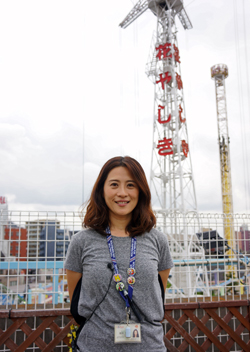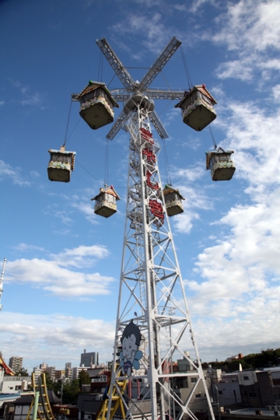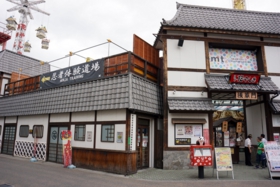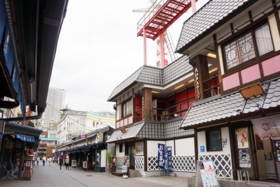
Aki Hozumi, Department of Future Business, Asakusa Hanayashiki
We talked with Aki Hozumi, Department of Future Business, Hanayashiki Inc. This interview was conducted in June 2015.
About the history of Asakusa Hanayashiki
Q: Could you talk about the history of Asakusa Hanayashiki, the oldest amusement park in Japan, up to the present day?
Hozumi : Hanayashiki was originally established as a flower garden called "Kaen" in 1853. Rokusaburo Morita, a garden designer, rented a section of the Senso-ji Temple precincts, and opened the garden in it.
Q: Is it opened in a place different from the present location?
The garden had more expansive grounds. According to the history chart of Hanayashiki, although it is now 6,150 square meters in area, it had an area of 8,000 square meters when it was opened. I heard that Rokusaburo was good at making peonies and chrysanthemum crafts, so such crafts were displayed.
Q: The Okuyama area was bustling with entertainments and festivities. Did Hanayashiki open as a part of those entertainments? At first, it was a botanical garden, wasn't it?
We call it "Kaen," but was also called "Ueki Jaya," literally meaning garden plant teahouse. It was a place where people enjoyed the beauty of flowers over a cup of tea. It was also a place where both upper class and common people could relax. It was like a present-day park.
Q: Has a flow of visitors changed from that of those days?
Judging from pictures taken in the early days, it seems that the present-day Asakusa Gate was the entrance. I think people entered Kaen from Senso-ji Temple. Even now, many people enter Hanayashiki from Senso-ji Temple.
Q: Taking a look at old pictures and postcards, it seems that there was a zoo. When did it has the zoo?
An exposition was held in Osaka in 1904. A manager of Hanayashiki at that time purchased animals displayed at the exposition, and kept those animals in Hanayashiki. Before that, rare birds, such as a white crow, were occasionally exhibited, but a full-scale exhibition of animals began in the late Meiji Period. Seeing a map of the zoo in the early Showa Period, it turns out that large animals, including elephants, bears, tigers and leopards, were exhibited. It is said that Hanayashiki is a birthplace of zoos in Japan.
Q: When did Hanayashiki become an amusement park?
Hanayashiki reopened as an amusement park after the Second World War. Hanayashiki was compelled to be used as an evacuation site after the Great Kanto Earthquake, so many animals needed to be killed with poison. Hanayashiki has such a history, so a stone monument for animals was erected.
Then, Hanayashiki was forced to be closed after the war. Many buildings in the Asakusa area were burnt down during the Great Kanto Earthquake, but buildings in Hanayashiki survived the fire.
Q: Ueno Zoo also opened in the Meiji Period. Were there some exchanges between Ueno Zoo and Hanayashiki?
Ueno Zoo opened as a full-scale zoo first, but Hanayashiki was earlier in terms of display of animals. An Asiatic elephant that was donated from Siam (present-day Thailand) and kept in Ueno Zoo for 35 years was transferred to Hanayashiki. There was such kind of exchange.
Q: Have streets and houses in Okuyama changed?
This area has been developed little by little. When the precincts of Senso-ji Temple was divided into seven sections, there was a plan to move Hanayashiki to the 6th section. However, the plan was not carried out, and Hanayashiki continued to operate in the same location, so Hanayashiki is now located a little bit away from Broadway Street in the 6th section.
Q: Is Hanayashiki now located in the 5th section in Asakusa?
Hanayashiki does not belong to any sections. However, at that time, there was a plan to assign the address "the 6th section" to Hanayashiki.
Q: Do traces of Kaen remain in Hanayashiki?
Although it is not exact traces of Kaen, there is still a special gardening team that cares for plants and flowers in the garden. There are several thousand species of flowers and plants in the garden, and seasonal flowers and plants are always exhibited, so those might be the traces.
Q: The entrance of Hanayashiki looks different from those of other amusement parks, and it has a very nostalgic exterior. Is Hanayashiki used as a movie location?
Speaking of old films, it is "Yume Miru Yoni Nemuritai" (1986), a film in which Shiro Sano played the leading role soon after making his debut. I think it was the black-and-white film. It was set in Hanayashiki. Speaking of recent ones, it is "Trick" (2002). The opening scene of magic performed by Yukie Nakama was shot on the central stage in Hanayashiki. The scene is used throughout all the series of the film. (continued in the right column)
The rooftop scene of "Helter Skelter" (2012), a film directed by Mika Ninagawa and starring Erika Sawajiri, was also shot in Hanayashiki. In any case, the "Bee Tower," a symbolic steel tower in Hanayashiki, on which a sign saying "Hanayashiki" is attached, is often used in films.

Q: Do many people come to Hanayashiki because they saw movies?
A large number of visitors come to Hanayashiki after seeing movies as well as TV programs.
Q: Do they take pictures at venues that were also used in movies? Do you also receive many inquiries about movie locations?
Yes. We receive many inquiries, such as about a chair on which a central character sat in a particular scene in a movie, or a place where a beverage that a character drank in a movie can be bought. We do not particularly tell visitors about it, but when we guide them around Hanayashiki, we tell them such things as much as possible.
We also get interviewed for TV. Also, Hanayashiki is sometimes depicted in comics. Osamu Akimoto, an author of cartoon "Kochira Katsushika-ku Kameari Koen-mae Hashutsusho," came to Hanayashiki several times, and he recently depicted "Panda Cars" in his cartoon. Speaking of other examples, in cartoon "Ike Inachu Takkyubu," a scene in which main characters rode in "Panda Cars" was depicted, so some visitors ride the cars in a way those main characters rode. Also, Hanayashiki was minutely introduced in "Love Live!," a recently popular cartoon. When the scene was set to air or rebroadcast, many people posted it in Twitter.
Q: Which points of Hanayashiki make good pictures?
As I said earlier, the Bee Tower is the symbol of Hanayashiki. In addition to it, there is Asakusa Gate. When Hanayashiki Street was developed in 2006, Asakusa Gate was remade into a gate that is full of a nostalgic atmosphere. Recently, the gate often draws attention. Visitors can enter Hanayashiki through both of the two gates.


Q: When Hanayashiki was Kaen, did visitors enter it through Asakusa Gate? Ryoun-kaku and a pond appear in an old picture.
Although I am not sure, it might be a picture of the area around Asakusa Gate. However, there is another gate, so it might be the area around "Shoun-kaku Gate" that is a parody name of Ryoun-kaku, in which a Chinese character "Sho," literally meaning laughing, is used instead of "Ryo" for Ryoun-kaku.
The pond still exists in the garden. Although it might be different from that of those days, Shiawase Bridge that is meant to give an impression of Okuyama is built over the pond. Also, there is a waterfall behind it. This is modeled after the view of Nikko, so some old posters saying "Let's see Nikko" have been preserved. There is such a playful spirit since olden days. In the past, visitors could climb up the back side of the hill that is modeled after Okuyama. Now, visitor cannot enter the area, but there are still some traces that reflect such a playful spirit. (continued in the next page)

Aki Hozumi, Department of Future Business, Asakusa Hanayashiki











